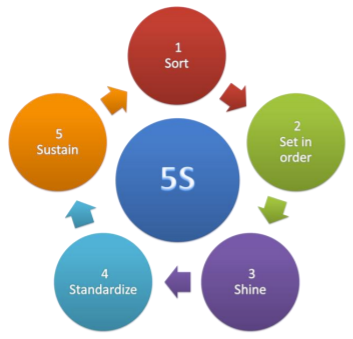3.5: Lean Manufacturing
- Page ID
- 39488
Lean is a manufacturing philosophy focused on waste removal developed by Toyota Production Systems (TPS) and popularized by the book “The machine that changed the world.” Lean seeks ways to improve the production process to accomplish more with less time, space, and resources. Elimination of waste is the centerpiece of this quality approach.
The lean approach recognizes seven forms of waste:
- Defective parts
- Producing more parts than needed
- Excessive inventory
- Unnecessary steps/activities
- Unnecessary movement
- Unnecessary handling of materials
- People waiting
5S
One important waste-eliminating quality system commonly implemented in biotechnology companies (such as Life Technologies) is the 5S system.

This system relies on visual cues to achieve an orderly workplace, and eliminates waste in the form of unnecessary steps, activities, movements, waiting around, and excess inventory. The 5S system – Sort (Seiri), Set in Order (Seiton), Shine (Seiso), Standardize (Seiketsu) and Sustain (Shitsuke) - provides a system for organizing, cleaning, developing and maintaining the work environment to minimize waste. youtu.be/jPXYa3FQP8k
The method encourages workers to participate in improving their workplace and process. Learn more about the 5S system here: http://leanmanufacturingtools.org/192/what-is-5s-seiri-seiton-seiso-seiketsushitsuke/
Explore!
Watch the following video to learn more about the 5S system. Using the 5S system, how can you organize your home office area to minimize waste in your studies?
Identify the 5S for improvement. What is the benefit of 5S? youtu.be/dDqmCJf0de0


